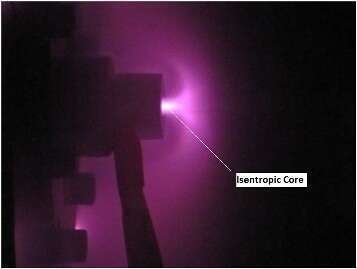The desired thrust profile for satellites are obtained using a parallel arrangement of two or more thrusters which may comprise of bigger and smaller thrusters. The under expanded plumes from these thrusters will have large peripheries owing to very high flow turning angles at very low back pressures. This causes plumes to be interacted with the adjacent ones.The interactions of the jets may lead to several problems such as changes in the thrust impulse profile, unwanted pressure forces on spacecraft surfaces and secondary external combustion if the unused propellants are passivated from the upper stages of the rockets as part of the international debris mitigation policy. Moreover there may be chances of back flow regions generated for strong interactions which cause contamination of sensitive electronic components.
The under expanded supersonic jet plume expanding into vacuum can be divided into three distinct flow regimes namely continuum, transition and free molecular, characterized by the Knudsen number [1]. The region near the nozzle exit where the gas density is maximum, can be treated as continuum flow and is called the isentropic core. At farther downstream, there exists a point where the continuum equations become invalid. Here the transition flow regime begins, which is followed by free molecular flow. When two thrusters have interacting plumes, the flow regimes formed may depend mainly on some parameters such as, back pressure, the exit Mach number of the thrusters and the distance between them.
Though numerical studies are available which analyze these interaction effects in the rarefied flow regimes [1], there have been hardly any experimental studies in this area. Many researchers have used DSMC method for the numerical investigation of dual interacting jets into vacuum. Most of the works were focused on the simulation of the primary and secondary shock cell structure when the dual interacting jets are expanded into a finite pressure. Dankert and Koppenwallner [2] introduced a penetration Knudsen number for interacting plumes in the rarefied regime and showed that if the penetration Knudsen number is less than 0.2, compression waves are developed in the interaction region and the mutual penetration of plume gases are only seen in the downstream region. This has been verified in an experimental investigation of two interacting thruster plumes using two identical nozzle thrusters by Holz[2] and they found out that the impingement effects of interacting plumes could not be obtained by the linear superposition of the single plumes as believed by many other researchers and the flow has different characteristics in the interaction region. In their work, the back flow regions were not investigated due to the pumping limitations. The current work focuses on studying the characteristics of plume interactions and the flow fields, especially the back flow regions, through measurement of jet pressure profiles and flow visualization for nozzles with various exit Mach numbers (area ratio), nozzle pressure ratios and separation distances.
The experiments are proposed to be conducted in the Rarefied Gas Dynamics (RGD) tunnel in the Department of Aerospace Engineering, IIT Madras, India. The facility consists of a vacuum chamber with a volume of 3.5 m3 which contains two sections. The upstream section, is the stagnation or high pressure chamber which is of 1 m length, and the downstream section( plenum chamber) or the low pressure chamber is of 3.5m length. The plenum chamber pressure can be maintained at pressures as low as 10-5 torr through multi-stage vacuum pumps. Various nozzle pressure ratios can be maintained by controlling back pressure in the plenum chamber and the stagnation chamber pressure. A scaled version of a 0.5N ERNO thruster nozzle used in satellite attitude control thruster rockets is used for the experiments. The convergent divergent nozzle has an area ratio of 59.97 and throat diameter of 1 mm. The test gas used is air.
Preliminary experiments have been conducted to visualize the flow fields for a single plume at various pressure ratios. Salient features of the flow fields have been identified as shown in Figures 1 (a) and (b).Fig 1(a) shows the plume expansion into a finite pressure and Fig1(b) shows the expansion into near vacuum. The isentropic core of the second case is much bigger than the first case and the thickness of the shock structure is also more. Experiments to capture the pressure and visualization data for the interacting jets are in progress.

Fig 1(a)

Fig 1(b)
REFERENCES:
1.Wenhai Li, Foluso Ladeinde (2011). Analysis of Interacting, Under expanded, Rarefied jets. AIAA Journal, Vol. 49, No.11
(2011).
2.Andre Holz, Georg Dettleff, Klaus Hannemann and Stefan Ziegenhagen (2012). Experimental Investigation of two Interacting
Thrusters- Plumes downstream of the nozzles. DLR Institute for Aerodynamic, Gottingen,Germany.

